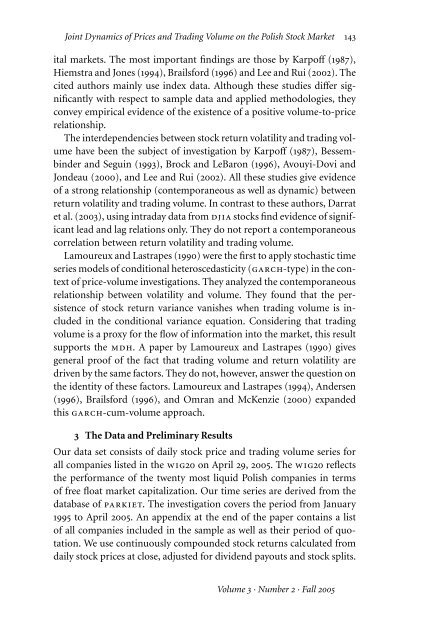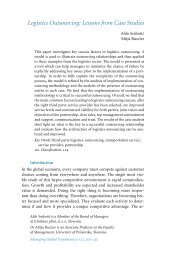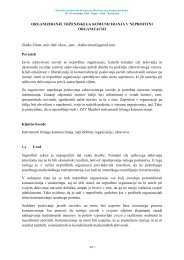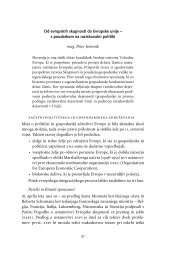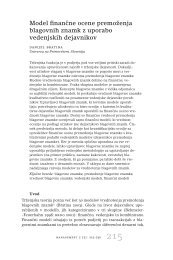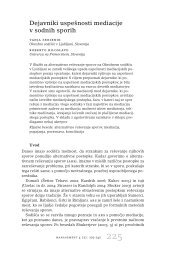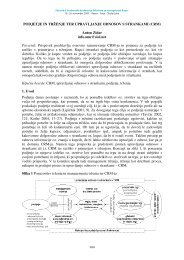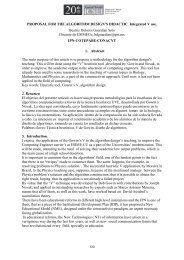Slovenia and Romania
Slovenia and Romania
Slovenia and Romania
Create successful ePaper yourself
Turn your PDF publications into a flip-book with our unique Google optimized e-Paper software.
Joint Dynamics of Prices <strong>and</strong> Trading Volume on the Polish Stock Market 143<br />
ital markets. The most important findings are those by Karpoff (1987),<br />
Hiemstra <strong>and</strong> Jones (1994), Brailsford (1996) <strong>and</strong> Lee <strong>and</strong> Rui (2002). The<br />
cited authors mainly use index data. Although these studies differ significantly<br />
with respect to sample data <strong>and</strong> applied methodologies, they<br />
convey empirical evidence of the existence of a positive volume-to-price<br />
relationship.<br />
The interdependencies between stock return volatility <strong>and</strong> trading volume<br />
have been the subject of investigation by Karpoff (1987), Bessembinder<br />
<strong>and</strong> Seguin (1993), Brock <strong>and</strong> LeBaron (1996), Avouyi-Dovi <strong>and</strong><br />
Jondeau (2000), <strong>and</strong> Lee <strong>and</strong> Rui (2002). All these studies give evidence<br />
of a strong relationship (contemporaneous as well as dynamic) between<br />
return volatility <strong>and</strong> trading volume. In contrast to these authors, Darrat<br />
et al. (2003), using intraday data from djia stocks find evidence of significant<br />
lead <strong>and</strong> lag relations only. They do not report a contemporaneous<br />
correlation between return volatility <strong>and</strong> trading volume.<br />
Lamoureux <strong>and</strong> Lastrapes (1990) were the first to apply stochastic time<br />
series models of conditional heteroscedasticity (garch-type) in the context<br />
of price-volume investigations. They analyzed the contemporaneous<br />
relationship between volatility <strong>and</strong> volume. They found that the persistence<br />
of stock return variance vanishes when trading volume is included<br />
in the conditional variance equation. Considering that trading<br />
volume is a proxy for the flow of information into the market, this result<br />
supports the mdh. A paper by Lamoureux <strong>and</strong> Lastrapes (1990) gives<br />
general proof of the fact that trading volume <strong>and</strong> return volatility are<br />
driven by the same factors. They do not, however, answer the question on<br />
the identity of these factors. Lamoureux <strong>and</strong> Lastrapes (1994), Andersen<br />
(1996), Brailsford (1996), <strong>and</strong> Omran <strong>and</strong> McKenzie (2000) exp<strong>and</strong>ed<br />
this garch-cum-volume approach.<br />
3 The Data <strong>and</strong> Preliminary Results<br />
Our data set consists of daily stock price <strong>and</strong> trading volume series for<br />
all companies listed in the wig20 on April 29, 2005. Thewig20 reflects<br />
the performance of the twenty most liquid Polish companies in terms<br />
of free float market capitalization. Our time series are derived from the<br />
database of parkiet. The investigation covers the period from January<br />
1995 to April 2005. An appendix at the end of the paper contains a list<br />
of all companies included in the sample as well as their period of quotation.<br />
We use continuously compounded stock returns calculated from<br />
daily stock prices at close, adjusted for dividend payouts <strong>and</strong> stock splits.<br />
Volume 3 · Number 2 · Fall 2005


